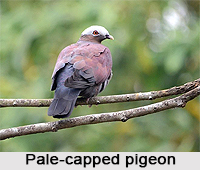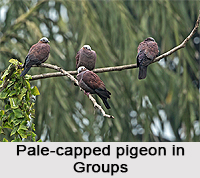 Pale-Capped Pigeon is an Indian bird that bears a scientific name "Columba punicea", widely found in the Indian states.
Pale-Capped Pigeon is an Indian bird that bears a scientific name "Columba punicea", widely found in the Indian states.
Pale-Capped Pigeon is a large purple wood pigeon that is a species of large pigeon that is found patchily distributed in parts of the Indian states and Southeast Asia.
Pale-Capped Pigeon has a slow flight and spends a lot of time sitting still in the foliage of large fruiting trees, often in riverine forest on the plains.
Behaviour of Pale-Capped Pigeon
Pale-Capped Pigeon is mainly brown above and chestnut below with sheen of green or amethyst. Males have a whitish grey cap while females have a brownish grey cap and less gloss on the feathers. They are frugivores, foraging in small groups in the canopy of trees but sometimes descending to the ground for seeds and fallen fruit.
Structure of Pale-Capped Pigeon
Pale-Capped Pigeon is a large 36 to 40.5 cm-long pigeon which is all-dark chestnut brown with a contrasting pale crown. The male has whitish-grey crown, purplish-maroon upperparts with faint green gloss on the neck; more strongly iridescent mantle and back; dark slate-coloured rump and upper tail-coverts; vinous-brown ear-coverts, throat and under parts slaty-grey under tail-coverts; and blackish tail and flight feathers. Females have a more brownish-grey crown.
Juvenile Pale-Capped Pigeon
The juvenile Pale-Capped Pigeon initially have the crown colour matching the mantle, duller wing-coverts and scapulars with rufous fringes, a much reduced gloss on the upperparts and greyer under parts. The legs are crimson and iris is creamy-yellow in adults. The skin around the eyes and the ceres are magenta.
Distribution of Pale-Capped Pigeon
Pale-Capped Pigeon is very locally distributed across its broad range, which encompasses parts of northern and north-eastern India, Bangladesh, Myanmar, Thailand, Laos, Cambodia and Vietnam. The type specimen was collected in Chaibasa, Singhbhum but relatively few records exist from Peninsular India. Records of the species exist from Maharashtra, Odisha, Bihar and Andhra Pradesh (Araku Valley, Andhra Pradesh).
Concentration of Pale-Capped Pigeon
Pale-Capped Pigeon are found mainly on the forests of the plains. It frequents a wide variety of habitats from the lowlands up to 1,600 m, chiefly primary or secondary evergreen forest, but also open, deciduous dipterocarp forest, bamboo, and agricultural fields, particularly in close proximity to forest. Mangroves, small forested islands and other coastal habitats are probably only frequented in the non-breeding season. It is mainly frugivorous, although seeds and grain form important dietary components in some areas.
It frequents a wide variety of habitats from the lowlands up to 1,600 m, chiefly primary or secondary evergreen forest, but also open, deciduous dipterocarp forest, bamboo, and agricultural fields, particularly in close proximity to forest. Mangroves, small forested islands and other coastal habitats are probably only frequented in the non-breeding season. It is mainly frugivorous, although seeds and grain form important dietary components in some areas.
Groups of Pale-capped pigeon
These pigeons fly about in small groups, foraging mainly in the morning and evening. They are said to have a low call similar to that of Ducula aenea but shorter and less prolonged. The breeding season is May to August and the flimsy platform nest is placed low down in a tree and one or rarely two eggs are laid. A species of helminth parasite, Cotugnia joyeuxi Baer, was first collected from this species from a Burmese specimen.











